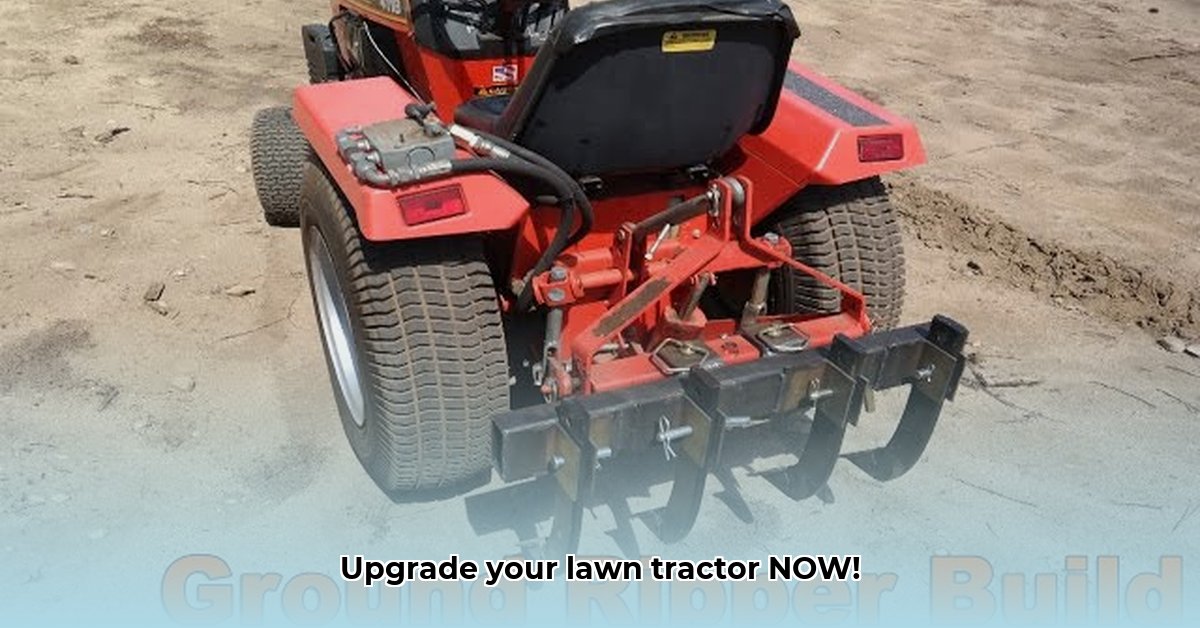
Choosing the Right Cultivator Attachment: A Comprehensive Guide
Tired of backbreaking work and uneven lawns? Investing in the right cultivator attachment for your lawn tractor can dramatically improve your gardening efficiency and results. This guide will walk you through selecting the perfect attachment, regardless of your experience level or budget. We'll compare different types, offer step-by-step installation instructions, and provide expert tips for long-term maintenance. Let's get started on your path to a healthier, more vibrant lawn! For more detailed information, check out this helpful resource: Lawn Tractor Cultivators.
Understanding Your Needs: Soil Type, Lawn Size, and Tractor Horsepower
Before you begin browsing cultivator attachments, assess your specific requirements. Just like you wouldn't use a hammer to screw in a screw, the right cultivator depends on your unique situation.
First, carefully examine your soil. Is it heavy clay, requiring significant tilling power to break it up, or lighter, sandy loam that needs a gentler approach? Clay soils necessitate a robust cultivator, while lighter soils are better suited to a less aggressive tool. Consider consulting a local agricultural extension office or soil testing service for a professional soil analysis.
Next, consider the size of your lawn or garden. A small vegetable patch requires a compact cultivator, while a large area demands a wider working width. Think of it like choosing a paintbrush – a small brush for detail work, a larger one for broad strokes.
Finally, and critically, check your lawn tractor's horsepower rating. Overloading your tractor with a cultivator that demands more power than it provides can lead to damage or even injury. Always consult your tractor's owner's manual to understand the recommended horsepower range for compatible attachments. Ignoring this crucial step can result in costly repairs.
Exploring Cultivator Types: Tines, Rotary, and Disc
Now let's explore the main types of cultivator attachments:
Tine Cultivators: These versatile workhorses utilize sharp metal blades (tines) to break up soil. They are suitable for a wide range of soil types and represent a good starting point for most gardeners. They offer a balance of power and gentle tilling.
Rotary Cultivators: These powerful tools use spinning rotors to pulverize the soil, creating a fine seedbed. Ideal for preparing soil for planting, they're excellent for lighter to medium soils. However, they may be less effective on very heavy clay.
Disc Cultivators: Designed for larger areas and heavy, compacted soils, these heavy-duty cultivators employ rotating discs to cut and mix the soil. They are best suited for breaking up hard-packed ground but require more maintenance.
Choosing the Right Cultivator: A Comparative Overview
The following table provides a comparison to help you decide, remembering that manufacturer specifications should always be consulted:
| Feature | Tine Cultivator | Rotary Cultivator | Disc Cultivator |
|---|---|---|---|
| Soil Type | Most soil types | Light to medium | Heavy, compacted |
| Tilling Depth | Moderate | Shallow to moderate | Deep |
| Lawn Size | Small to large | Small to medium | Large |
| Maintenance | Relatively easy | Moderate | More demanding |
| Cost | Moderate | Medium | Higher |
Attaching and Using Your Cultivator: A Step-by-Step Guide
Installing a cultivator typically involves attaching it to your tractor's three-point hitch. Always consult both your tractor and cultivator manuals for detailed, model-specific instructions. Safety is paramount! Wear safety glasses and sturdy footwear during operation.
Step 1: Securely connect the cultivator to the three-point hitch, ensuring a firm and stable connection.
Step 2: Adjust the tilling depth, starting shallow and gradually increasing as needed. Soil type and cultivator design dictate appropriate depth.
Step 3: Engage the PTO (Power Take-Off), the mechanism that powers the cultivator. Refer to your tractor's manual for the correct procedure.
Step 4: Begin tilling, overlapping passes to ensure even soil coverage. Work at a steady pace, taking breaks when necessary.
Step 5: Once finished, disengage the PTO and carefully remove the cultivator.
Maintaining Your Cultivator for Peak Performance
Regular maintenance is crucial for extending the lifespan and efficiency of your cultivator. Sharpen or replace worn tines, lubricate moving parts as recommended by the manufacturer, and store the attachment in a dry location to prevent rust and corrosion. Preventative care saves you time, money, and potential frustration down the line. Isn't it interesting how a little maintenance can make such a difference?
Key Takeaways: Choosing the Best Cultivator for Your Needs
- Soil type is the primary factor in cultivator selection.
- Tine design significantly impacts tilling performance.
- Tractor horsepower and attachment compatibility are crucial considerations.
- Durability and ease of maintenance are essential for long-term value.
Choosing the right cultivator attachment is a significant investment. By carefully considering your specific needs, soil type, lawn size, and tractor capabilities, you can ensure the best possible results. Happy cultivating!